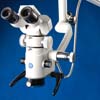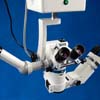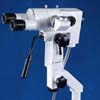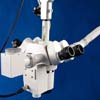Injuries And Diseases Of The Drumhead
Injuries And Diseases Of The DrumheadBY H. V. WURDEMANN, 24. D.,
OF MILWAUKEE, WIS.
Traumatic Lesions of the Drumhead. Considering the delicacy of the tympanic membrane and the relative frequency of accidents to the head it is seldom liable to injury, thanks to its protected situation within the skull at the bottom of the external auditory canal.
Homorrhage. Sneezing or coughing, especially in pertussis or in asthmatics with arterio sclerosis, may produce circumscribed hemorrhages in the membrane (Plate 11, Fig. 2). Patients experience transient, slight pain, and examination reveals dark red or brown, circumscribed spots, which cannot be wiped away. Such may occur after Politzer's method of inflation, catheterization, after sudden condensation or rarefaction of the air in the external meatus, and from direct injury without perforation of the membrane. Hyperemia and hemorrhage occur in the course of myringitis and otitis media from acute infectious disease' (due to rupture of The small blood vessels causing true hemorrhage in the dermal layer), in dense or rarefied atmospheres from the same cause, as in the case of miners or divers, and mountain climbers or aeronauts, or in persons who have not been accustomed to sudden changes of atmospheric pressure. It is also an occasional accompaniment of scorbutus, typhus, dengue, bubonic plague, and other infectious diseases. Vicarious hemorrhage has also been reported.
Direct injuries to the membrane are oftenest observed after unskilful attempts to remove foreign bodies by patients, their friends or physicians (Plate 11, Figs. 3, 4). Slight injuries are sometimes self inflicted by persons who are accustomed to remove wax or scratch the canal with ear spoons, toothpicks, etc. (Plate 11, Fig. 5), or who have acquired the habit of scratching their ears 3 with pencils or pen holders while deep in thought (Plate 11, Fig. 6). 111considered attempts at removal of foreign bodies and of inspissated cerumen (Plate 11, Fig. 7) by forceps, scoops, or syringes with long nozzles may cause dangerous injuries. In cases of myringitis or after gentle removal of impacted cerumen, the simple application of a cotton pledget for drying the ear may rub away the epidermal layer. If aseptic, such slight injuries heat within a few hours. The forcible entrance of water or foreign bodies, such as insects, twigs, etc., into the canal gives rise to superficial or deep injury. The instillation of strong medicinal solutions, as caustics, the use of very hot or very cold solutions, as hot glycerin (Plate 11, Fig. 8), olive oil, etc., may cause lesion of the canal and external layer. A means of torture in ancient times was pouring of hot wax or lead into the ears, which produced effects varying from superficial injury to death; and the membrane may now be injured in metal workers by the splashing of molten metal. Direct injury and even perforation from the tympanic side has been produced by the Eustachian bougie (Urbantschitsch). Direct injuries, Such as punctures and abrasions, are usually found in the anterior half, as pointed objects slide off the more obliquely placed posterior portion of the membrane (Politzer).
Rapture of the drumhead is frequently caused by slapping the face and ears of children for punishment by teachers or parents, thus producing sudden compression of air in the external meatus. It occasionally Occurs in sparring (Plate 11, Fig. 9), and is common from injuries caused by explosions of gunpowder, dynamite, fire arms, and boilers. Improper inflation methods, such as the use of compressed air apparatus at high pressure, the catheter or Politzer bag by unskilled hands or in improper cases, may produce rupture of the drumhead. Spontaneous perforation frequently occurs in acute catarrhal or suppurative otitis media. Fracture of the base of the skull is generally attended by bleeding from the ear and rupture of the membrane (Plate 11, Figs. 10, 11). A diseased, inflamed, or weakened drumhead is more liable to injury than if normal, especially where there has been misplacement or thinning of its structure. The normal drumhead is resilient, and cannot be ruptured under a pressure of 4 or 5 atmospheres (Gruber). The flaccid membrane is seldom broken, as it is less tense and plays an important part in preventing ruptures.' The so called Rivinian foramen does not commonly exist in the normal subject, and is not the safety valve which has been supposed. The situation of the rupture is indifferently placed in the anterior or posterior halves of the tense membrane, usually near the handle of the malleus. It may be single or double, depending upon the character of the injury. Both large and small perforations may follow slight blows upon the head. The handle of the malleus (Plate 11, Fig. 11) is rarely fractured, although cases have been reported, as well as of dislocation 2 (plate 11, Fig. 3).
Symptoms. At the time of the injury there is sharp pain, which may last for several hours, and is usually accompanied by dizziness and sometimes by nausea. If the upper part of the drumhead be injured disturbance of the sense of taste may occur, as where the chorda tympani nerve is divided in operations, but recovers after several weeks. If seen shortly after lacerating injuries, there will be found fresh blood or clots in large or small amount in the meatus or on the drumhead, or, if the perforation be large, in the middle ear. The edges of the wound are at first irregular and covered with fresh blood. Twenty four hours after the injury, however, there is usually hyperemia, especially of the edges of the perforation, which appear more even. If the ear has been tampered with or not occluded from the atmosphere, infection followed by acute suppuration and sometimes persistent perforation may occur. Simple puncture by clean instruments, such as the paracentesis knife, in ears that are aseptic and not inflamed, will frequently in a few hours heal and close without cicatrix.
The diagnosis of traumatic injury, perforation, or rupture may generally be made by its appearance and the history. If seen shortly after the accident, the edges of a rupture are found gaping, so that the yellowish red lining membrane of the tympanic cavity may be seen. Fresh bleeding is of course diagnostic. A differential symptom is the character of the sound on inflation, as in traumatic perforation the whistle is said to be deep and harsh, while in pathologic perforation it is sharp and shrill (Politzer). It is of forensic importance to determine whether or not a perforation be traumatic or due wholly or in part to disease, especially in cases following blows upon the head and boxing the ears, as the statements of patient and friends are frequently influenced by personal motives. Study of the other ear may give valuable light.
The prognosis of simple injury and perforating wounds is good if the car be clean and secondary infection does not take place, as the drum membrane quickly regenerates; in fact, it is the experience of most surgeons that it is difficult to maintain a permanent opening. Simple injury of the drumhead, as in surgical perforation, seldom has any deleterious influence upon the hearing. In fracture of the base of the skull attended by bleeding from the ear, rupture of the drumhead and lesion of the labyrinth usually occur; the prognosis is unfavorable as regards the bearing and sometimes as to life.
The treatment of most injuries of the drumhead after removal of foreign bodies and cleansing consists in letting well enough alone; the ear should not be douched, nor should solutions be instilled. The canal may be syringed or wiped out with warm saturated boric acid or I: 5000 sublimate solutions, etc., dried and dusted with impalpable boric acid, aristol, or iodoform powder and the canal stopped with iodoform gauze and absorbent cotton. After twenty four hours the dressing may be removed and renewed. Within a few days the healing will usually have so far progressed that unless extensively destroyed the membrane has been restored. Even . after extensive operations involving the removal of the drumhead and ossicles, although necrosis may have occurred, and after the mastoid operation, if treated in this manner, infection and suppuration rarely 'ensue.
Acute Primary Inflammation of the Drumhead (Myringitis Acuta). A diagnosis of acute inflammation of the drumhead is less often made than formerly. Its most common causes are said to be due to the entrance of cold droughts or cold water into the external canal. I have more often seen it after attempted removal of cerumen, foreign bodies, or water from the ears, after instillation of irritating or hot solutions (Plate 11, Fig. 8), or in connection with aspergillic inflammation of the canal (Plate 11, Fig. 12). There is slight pain, tinnitus, and a throbbing sensation, with but little deafness. At first there is hyperemia and later effusion of clear or bloody serum from the breaking down of vesicles, which may involve a portion or all of the dermal layer (Plate 11, Fig. 13). Some cases of otitis attended by slight serous discharge, followed by resolution after a few days, are of this form. Sometimes abscesses (Plate 11, Fig. 15) develop under the outer layer, but are usually followed by perforation, presenting a picture similar to acute suppurative otitis media. After the vesicular stage the membrane will have a macerated appearance, more or less of the dermal layer peeling and the redness disappearing (Plate 11, Fig. 12).
The treatment depends upon the cause. In all cases it is necessary to cleanse the canal by antiseptic solutions to prevent infection. The vesicles may be punctured, the ear insufflated with boric powder, and the meatus occluded by iodoform gauze and cotton. In severe cases, cupping, leeching, and hot applications to the side of the bead may be necessary. Opiates may be given if the pain be severe, although when such is the case there is usually development of abscess, the puncture of which will relieve the pain.
Chronic Inflammation of the Drumhead (Myringitis Chronica). Clironic inflammation of the middle ear is generally accompanied by implication of the drumhead. Chronic myringitis alone is very rare, although it is possible that such may be found after acute myringitis which has not gone on to resolution.' After inflammation of the canal has disappeared' the drumhead sometimes remains affected, and this may be considered an independent disease.' The clinical signs are maceration of the dermal layer, redness and sometimes granulations upon the surface (Plate 11, Fig. 16). There is but little pain, and the hearing is but little affected. Tinnitus and slight malodorous purulent discharge usually exist. Middle ear suppuration with unseen perforation is to be suspected and sought. In perforation of the drumhead polypi and granulations may form upon the edges.
The treatment is antiseptic. It consists in cleansing the canal and membrane by injections or brushing with solutions of boric acid, bichlorid of mercury, etc., after which a small quantity of finely powdered boric acid or aristol may be insufflated, or a small pledget of cotton saturated in salolcamphor or naphthol camphor may be placed in the canal, to remain twentyfour hours and then be renewed. Granulations may be touched with tincture of chlorid of iron, nitrate of silver, chromic or trichloracetic acids. Instillations of solutions by patients are to be discouraged.
Infectious and skin diseases, as well as the exanthemata, may affect the drumhead (Haug) ; the eruption of these and of syphilis is sometimes to be seen in the dermal laver. The pustule of small pox may have been the cause of several cases of middle ear suppuration which I have' seen after this affection. Condylomata 3 of the auditory canal and drumhead have been reported by the writer and others.
New Growths. Warts (Burnett) rarely occur on the drumhead, and are usually due to instillation of fluids. I have seen true epithelioma of the canal involving the drumhead. Pearly growths consisting of cholesterin crystals and molecular debris were found in a case of chronic suppurative middle ear disease; true cholesteatomata are rare (Gruber). Calcification in the drum membrane is frequently found in the course of chronic otitis media (Plate 11, Figs. 17, 18), although it is seen when there. is no other evidence of eardisease (Plate 11, Fig. 19). The membrane becomes thickened (Fig. 20), thinned (Plate 11, Fig. 21), or opaque and perforated (Plate 11, Figs. 17, 22, 23, 24), as the result of chronic inflammation in the middle ear and canal. They are likewise due to trauma and ulcerations, such as occur in syphilitic or tubercular (Plate 11, Fig. 24) middle ear disease.
Polypi usually arise from the tympanic mucous membrane; but are sometimes on the edges of perforationsm most frequently at the posterior superior quadrant. Mucous polypi and myxomata are most, common, although fibromata and angiomata' are seen. These growths are accompanied by malodorous otorrhea, and are but part of a chronic suppurative process which is usually attended by necrosis of the walls of the tympanum and of the ossicles, and their removal may be a needed preliminary to treatment for the chronic suppuration. Granulations are preferably removed by the small curette, and polypi by the cold snare, and their pedicles cauterized by tincture of the chlorid of iron, nitrate of silver, chromic or trichloracetic acid on a small pledget or fused on the end of a probe; but with these or with the galvano cautery care should be taken that nothing but the growth be touched. Granulations recur unless the suppurative disease be healed.
Back to Resources
call toll-free:  or email
or email

 or email
or email
Categories
Categories
Dental
Dental Microscopes
Dental Microscopes
Ophthalmic
Ophthalmic Microscopes
Ophthalmic Microscopes
Gynecology
Gynecology Colposcopes
Gynecology Colposcopes




